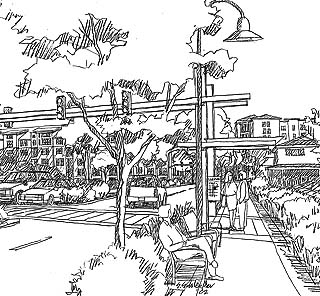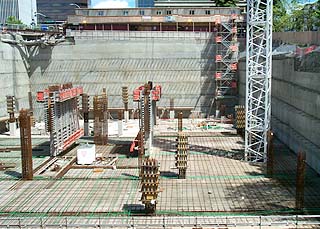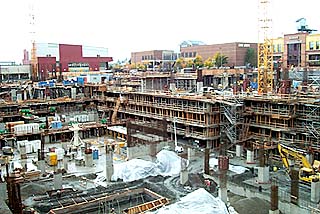
Surveys
DJC.COM
February 27, 2003
In Bellevue, holes aren’t the whole story
CollinsWoerman

Rendering courtesy of CollinsWoerman
Mid-block crossings, which let pedestrians cross downtown’s long blocks at various halfway points, are one feature of Bellevue’s Downtown Implementation Plan that residents could see happen within two to three years.
|
What images come to mind when someone mentions “downtown Bellevue?”
Bellevue Square? Downtown Park? Meydenbauer Center?
For many, it’s the image of the “holes in the ground” — a daily reminder of the pains a cyclical economy can bring to a commercial real estate marketplace.
Despite their compelling visual nature, these holes are not the whole of downtown Bellevue.
The challenges and slowdowns of a down economy are short-term issues that are part of any cyclical economic downturn and are clearly put into perspective after a look into the long-term comprehensive planning that well-run cities, such as Bellevue, practice and implement.
The holes are a speed bump — not a roadblock — for the city.
The current visual state of downtown Bellevue may make it seem as though the city is not progressive, but that is hardly the case.
Bellevue has a plan.
It’s a plan that builds on successes and goals that are almost 25 years in the making and enable downtown Bellevue to continue to be the well-run city that it is, while balancing the new homes and business and increased traffic that are slated for downtown by the Growth Management Act.
For example, by 2020, more than 79,000 people are expected to work in downtown Bellevue, doubling its current workforce, and more than 14,000 residents will call downtown Bellevue home, quadrupling its current resident population.
With all this growth and change coming its way, one might conclude that after 50 years, Bellevue is finally coming of age.
And with age comes wisdom and the knowledge that to be a success, most things require a solid plan.
Bellevue’s plan, called the Downtown Implementation Plan, is a 20-year plan that builds upon the successes and milestones achieved by the city with its first 20-year comprehensive plan, which was enacted in 1980.
The foundation for making Bellevue a truly livable city has been laid and is already under way, despite the current commercial real estate environment.
Now is the perfect time for action and a major milestone on the Downtown Plan was already reached this month.
After two years of work, a citizens’ advisory committee comprised of more than 45 Bellevue residents, downtown neighbors, business owners and civic leaders on Feb. 4 approved the final urban design and transportation plan for the 20-year Downtown Implementation Plan.
“Bellevue has a stable vision of itself, and its neighbors and residents are very involved in helping this vision take shape,” said Matt Terry, Bellevue’s director of planning for more than 20 years. “We are a city that knows the value of citizen participation — our citizen’s have helped design and approve the Access program, existing infrastructure advancements and tax rates that help make Bellevue a clean, well run and competitive city.”


Photos by Benjamin Minnick
Two big holes in Bellevue include the Bellevue Technology Tower, top, and Lincoln Square, shown under construction.
|
The urban design component of the Downtown Implementation Plan is a vehicle for downtown Bellevue providing livability solutions that can be realized six months from now as well as 20 years in the future.
The newly approved urban design plan will go beyond transforming Bellevue from a collection of great pieces to a “great place.” However, achieving this goes beyond creating wider sidewalks and shorter city blocks. This requires acting on the citizen-approved vision to make Bellevue a premier city that is able to attract creative, ambitious and community-minded people.
For example, pedestrian mid-block crossings will make city blocks shorter, easier to cross and its streets more walkable. Integration of the neighborhoods around city center will begin with construction of a variety of mixed-use buildings to soften the dividing lines between neighborhoods on the outlying edges of downtown Bellevue.
After 50 years, downtown Bellevue is finally hitting its prime. The Downtown Implementation Plan is not just talk and politics — there is leadership and resolve behind making downtown Bellevue a truly livable place and a center for the Eastside.
Next time someone mentions downtown Bellevue and its “holes in the ground,” remind them: Bellevue has a plan.
Arlan Collins is a principal at Bellevue-based CollinsWoerman, an architecture, design and urban planning firm.
Other Stories:
- Seattle’s economy: Out of sync?
- Insurance industry weathers a ‘perfect storm’
- Marketing homes during war
- Creating suburban living in the city
- Young blood takes on a challenging market
- Mortgages and technology: A Catch 22
- The moisture vs. energy code balancing act
- Colleges face big real estate challenges
- Cooking up a new business? Think incubator
- New laws needed to fight insurance crisis
- TODs: Look beyond the physical characteristics
- Monorail expected to spark new development
- Affordable housing still GMA challenge
- Third time’s the charm for Lakewood retail
Copyright ©2009 Seattle Daily Journal and DJC.COM.
Comments? Questions? Contact us.